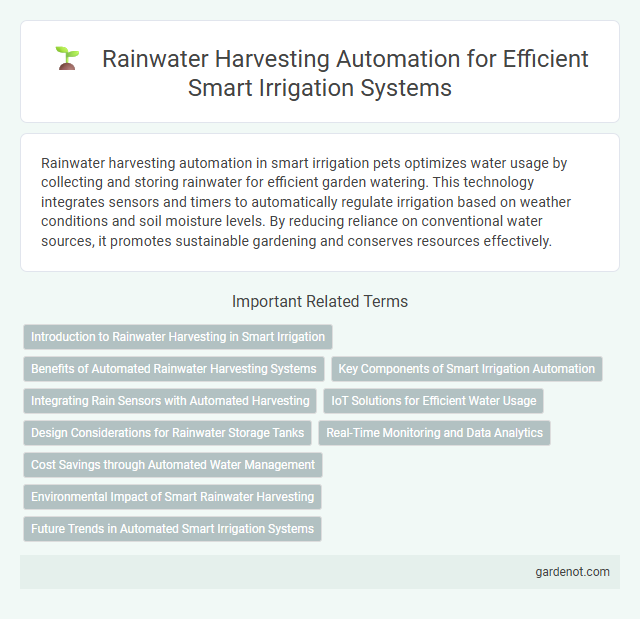Rainwater harvesting automation in smart irrigation pets optimizes water usage by collecting and storing rainwater for efficient garden watering. This technology integrates sensors and timers to automatically regulate irrigation based on weather conditions and soil moisture levels. By reducing reliance on conventional water sources, it promotes sustainable gardening and conserves resources effectively.
Introduction to Rainwater Harvesting in Smart Irrigation
Rainwater harvesting in smart irrigation captures and stores rainwater for efficient landscape and crop watering, reducing dependence on traditional water sources. Automated systems utilize sensors and weather data to optimize water collection and distribution, ensuring precise irrigation schedules. Integrating rainwater harvesting with smart irrigation technology enhances water conservation and promotes sustainable agricultural practices.
Benefits of Automated Rainwater Harvesting Systems
Automated rainwater harvesting systems optimize water collection by using sensors and control units to activate storage and distribution processes precisely when needed, reducing water wastage significantly. These systems enhance irrigation efficiency by providing a sustainable and cost-effective water source, decreasing dependency on municipal supply and ensuring consistent moisture levels for crops. Improved water management with automation supports environmental conservation by minimizing runoff and soil erosion, contributing to long-term agricultural sustainability.
Key Components of Smart Irrigation Automation
Rainwater harvesting automation in smart irrigation systems relies on key components such as sensors, automated valves, and controllers to efficiently capture, store, and distribute rainwater. Soil moisture sensors and weather data integration optimize irrigation schedules by adjusting water delivery based on real-time environmental conditions. Smart controllers coordinate between harvested rainwater storage tanks and irrigation zones, maximizing water conservation and reducing reliance on traditional water sources.
Integrating Rain Sensors with Automated Harvesting
Integrating rain sensors with automated rainwater harvesting systems enables precise detection of rainfall, optimizing water collection and reducing waste. These sensors trigger pumps and valve controls to adjust harvesting activities based on real-time precipitation data, enhancing irrigation efficiency. This automation supports sustainable water management by ensuring that harvested rainwater is stored and utilized only when necessary, minimizing reliance on traditional water sources.
IoT Solutions for Efficient Water Usage
Smart irrigation systems leverage IoT solutions to automate rainwater harvesting, optimizing water collection and distribution based on real-time weather data and soil moisture levels. Sensors integrated with cloud-based analytics enable precise control of irrigation cycles, reducing water waste and enhancing resource efficiency. Automated rainwater harvesting not only conserves potable water but also supports sustainable agriculture by maximizing the use of natural rainfall.
Design Considerations for Rainwater Storage Tanks
Rainwater storage tank design for smart irrigation automation must prioritize optimal capacity based on local rainfall patterns and garden water demand to ensure efficient resource use. Material selection should emphasize durability and food-grade quality to prevent contamination, while incorporating sensors for automated water level monitoring and overflow management enhances system reliability. Proper tank placement and integration with filtration units guarantee consistent water quality, supporting sustainable irrigation practices.
Real-Time Monitoring and Data Analytics
Rainwater harvesting automation enhances smart irrigation by integrating real-time monitoring sensors that track rainfall intensity and water storage levels. Advanced data analytics processes this information to optimize water distribution, ensuring efficient irrigation schedules and reducing water waste. This technology supports sustainable agriculture by dynamically adjusting irrigation based on accurate environmental data, promoting resource conservation.
Cost Savings through Automated Water Management
Rainwater harvesting automation significantly reduces water bills by optimizing irrigation schedules based on real-time weather data and soil moisture levels. Automated systems minimize water wastage and enhance crop yield by precisely delivering the right amount of water, decreasing the need for expensive municipal or groundwater resources. Integrating smart sensors and IoT technology ensures efficient water use, leading to substantial long-term cost savings for agricultural and landscape irrigation.
Environmental Impact of Smart Rainwater Harvesting
Smart rainwater harvesting automation significantly reduces freshwater consumption by efficiently collecting and storing precipitation for irrigation purposes, thereby lowering dependency on municipal water sources. This technology minimizes runoff and soil erosion, enhancing groundwater recharge and promoting sustainable water management in agricultural landscapes. Implementing automated rainwater systems also decreases energy consumption and greenhouse gas emissions associated with conventional irrigation methods, contributing to environmental conservation.
Future Trends in Automated Smart Irrigation Systems
Future trends in automated smart irrigation systems emphasize the integration of rainwater harvesting automation to enhance water conservation and efficiency. Advanced sensors and AI-driven algorithms optimize the collection, storage, and distribution of rainwater, reducing dependency on traditional water sources. Innovations in IoT connectivity enable real-time monitoring and adaptive irrigation schedules that respond dynamically to weather patterns and soil moisture levels.
Rainwater harvesting automation Infographic

 gardenot.com
gardenot.com